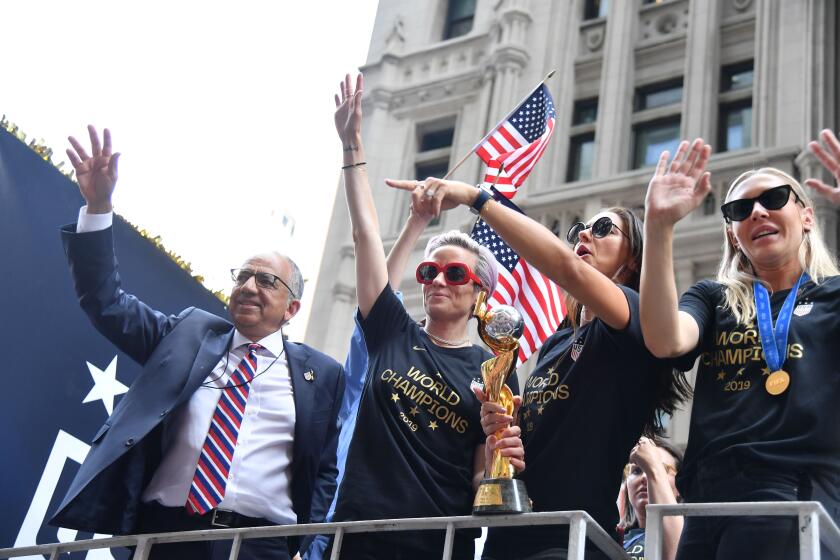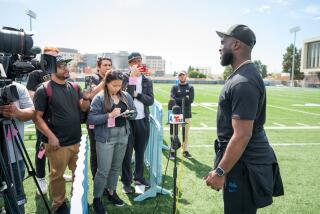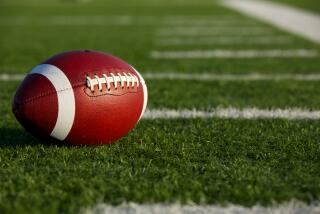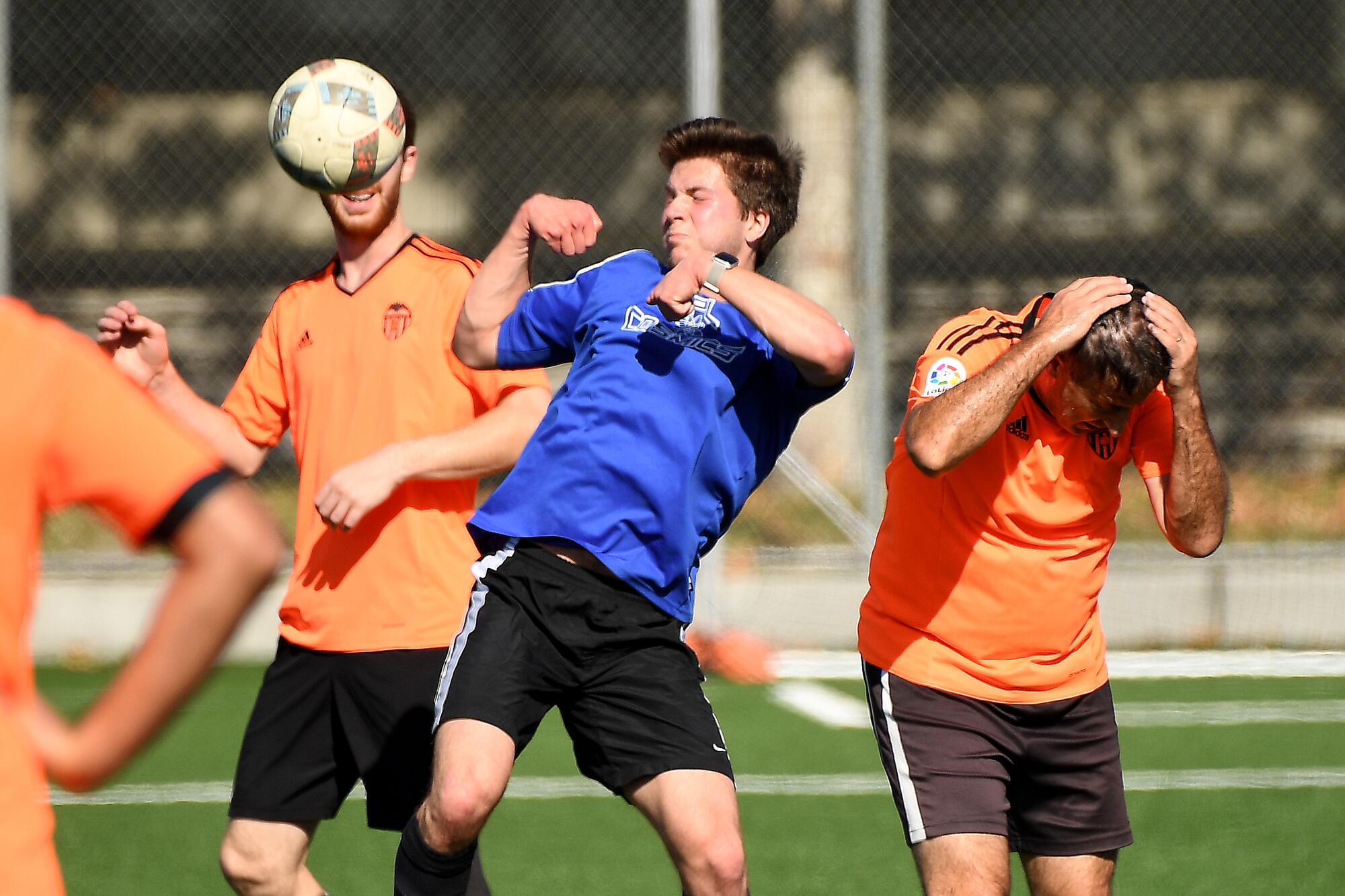
Astrophysicists, engineers, biologists and more play in what they proudly call the Nerd League.
- Share via
The first thing you notice about the Sunday soccer league at Caltech is how much time the ball spends on the ground. Heading isn’t illegal here, but it is unwise.
“I don’t do headers,” said Paolo Celli, a post-doctorate student in mechanical engineering from Italy. “The ball is super hard.”
And since Celli and other players in the so-called Nerd League are super smart, it’s not exactly rocket science to say that protecting their brains is far more important than the outcome of a match.
But that doesn’t mean players don’t use their heads.
“If you think about it,” said Vahag Karayan, 44, an expert in electrical engineering who was part of the original Mars rover team at JPL, “we have more master’s and PhDs than any other league would have.”
The sideline banter proves that. In what other league would schadenfreude be considered trash talk? Where else would errant shots be blamed on poor vectoring?
“You’re as likely to hear about the coding algorithms behind a virtual-reality system or interstellar travel or geological eras at halftime as you are to hear about any soccer strategy,” said Harry Atwater, a world-renowned professor of applied physics and materials science and a forward.
The Caltech league, which has been around for about four decades, has seven teams with names such as the Cataclysmic Variables, IcyGood and the Cosmics — the latter of which bears no resemblance to the Cosmos, the New York professional team for which the legendary Pelé once played.
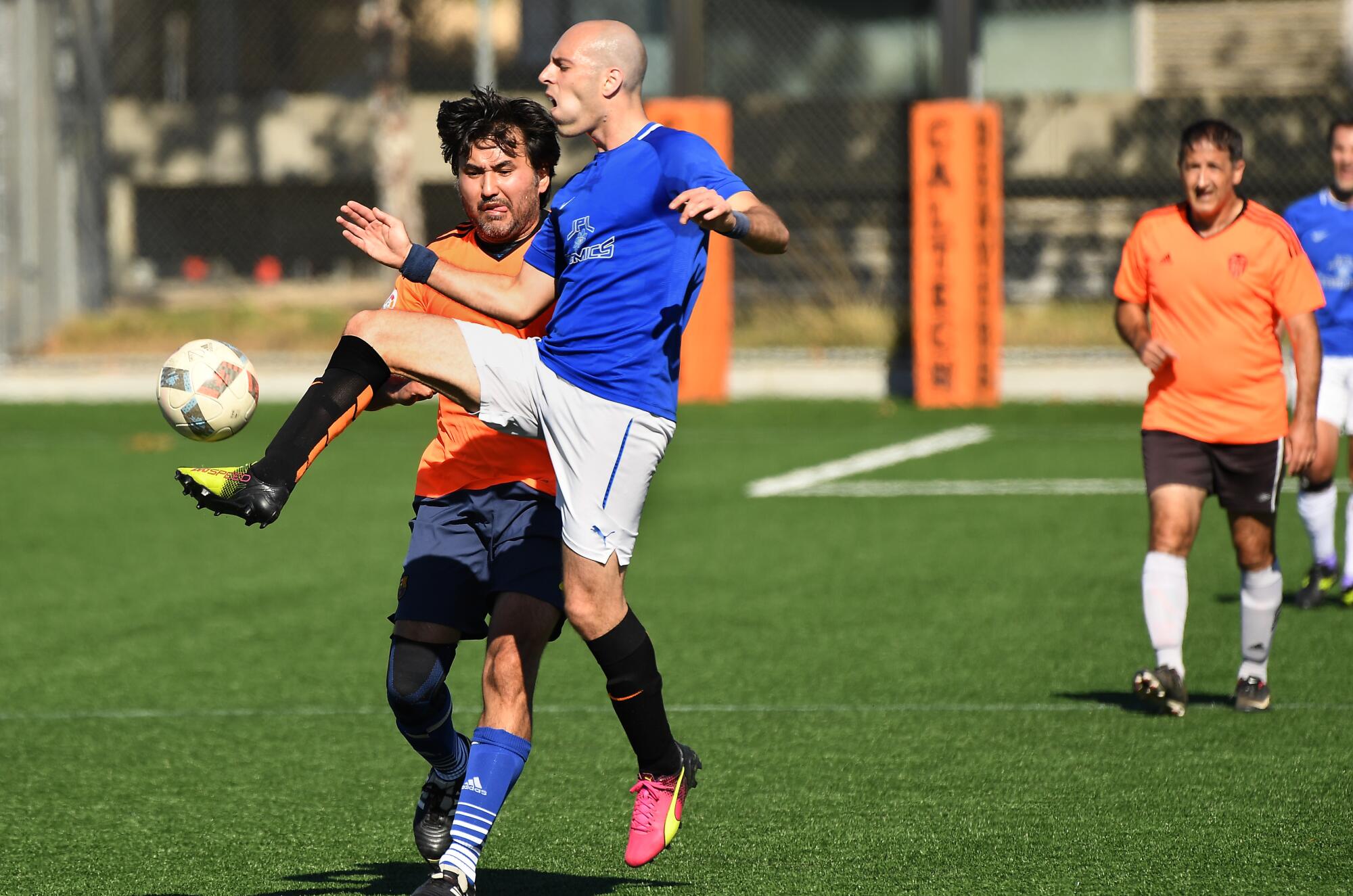
The teams compete in a 10-week fall season and a five-month spring season, with each squad representing an area of study such as astronomy, biophysics or aerospace.
Players — who hail from nearly two dozen countries — range in age from their early 20s to 63-year-old goalkeeper Chad Edwards, a NASA engineer. And because many of them are scientists with ties to Caltech or the nearby NASA Jet Propulsion Laboratory, the league, like the universe, has objective rules: No slide tackles, no swearing and any player receiving a red card must leave the facility immediately.
Other than that, it’s just like the World Cup.
OK, not really.
In fact, when the Cosmics and SOPS (Society of Professional Students) met on a sun-dried November afternoon in a game with championship implications, the size and shape of the ball was about the only thing reminiscent of the World Cup.
Yet it was clear both sides were competing for more than bragging rights at the next aerospace convention. In the second half, Matt Heverly, a slightly built Cosmics midfielder, collided with stocky SOPS captain Taeho Kim, a crash that sent Heverly to the sidelines checking to make sure he hadn’t bitten off the end of his tongue. (He hadn’t.)
Bob Gutzman, the son of a chemist, who plays viola in the Caltech orchestra and sweeper for the Cosmics, broke the collision down this way. “F = ma. Force equals mass times acceleration. You don’t have very much m,” he told Heverly, “so you need a lot more a.”
The uniforms were as ragged as the game, with players in mismatched jerseys and shorts spraying passes around a bumpy grass field. Some of the red SOPS jerseys have “Ernie’s” in script across the front, a nod to the owner of a neighborhood restaurant who paid for the shirts.
The center of the royal-blue Cosmics’ jersey features a tiny atom structure with a soccer ball as the nucleus.
“We’re sponsored by the universe,” explained one player.
The league, meanwhile, is sponsored by the university, which also offers 16 intercollegiate teams — eight for men, eight for women — and seven intramural sports, including flag football, kickball and dodgeball.
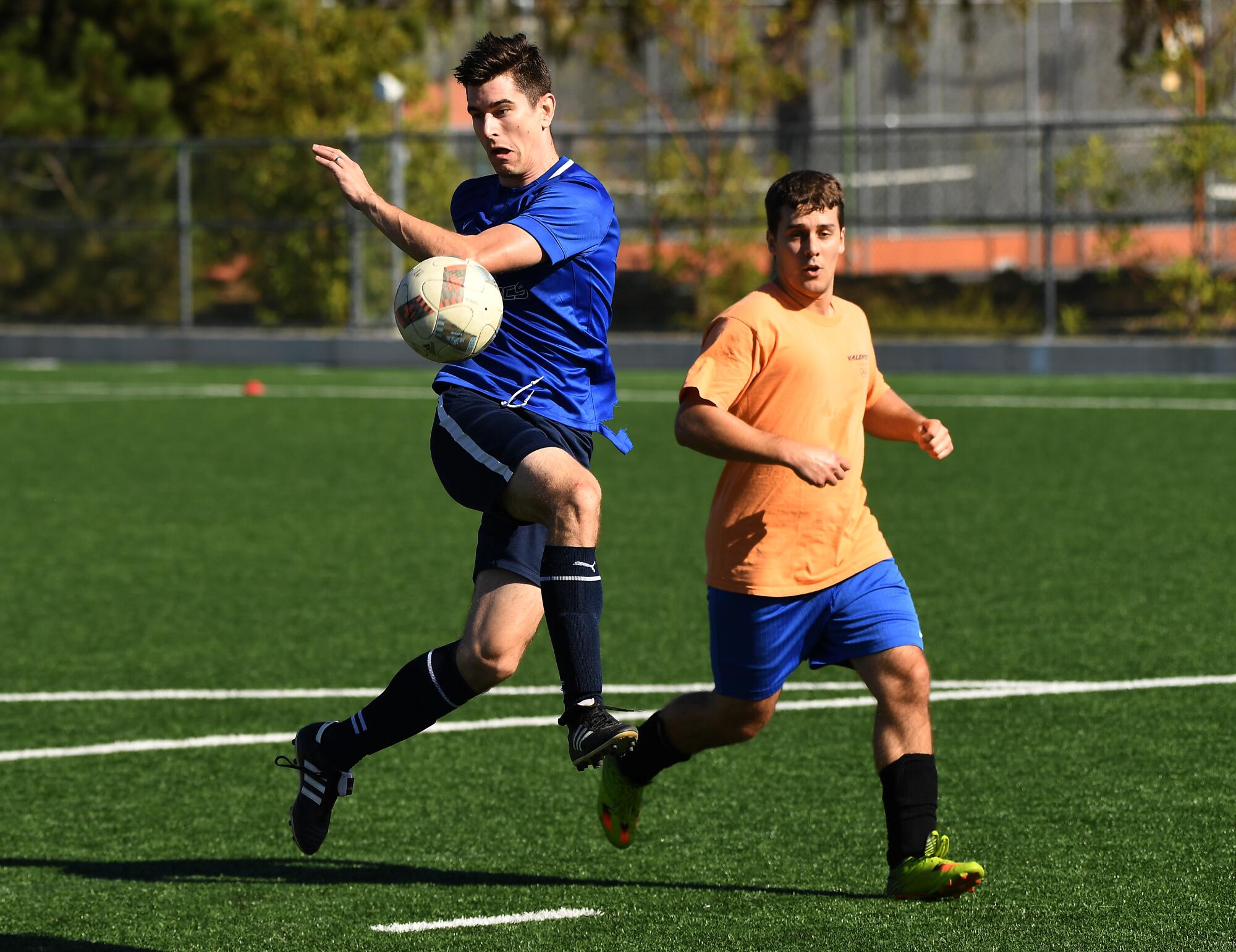
Sports have proven a vital distraction at an institution whose alumni, faculty and researchers include 38 Nobel Prize recipients — none of whom can be remembered as having played in the Sunday soccer league.
“I have played basketball with a number of Nobel Prize winners,” assured Atwater, a pioneer in nanophotonics and plasmonics.
“I’ve been playing soccer for 35 years,” said Atwater, 59, who has been in the Caltech league so long he once flattened an opposing player he had coached years earlier in the American Youth Soccer Organization. “Soccer is definitely one of my personal life priorities.”
Atwater’s team is the Cambrian Explosion, a mix of players from the geology and applied physics departments. But don’t let the funny team names and the advanced degrees fool you, he said.
“If you hang around scientists and people from Caltech for a while, you realize they’re pretty serious about a lot of things,” he said. “Once you get on the soccer field, it’s a challenge just like any scientific challenge. And you step up to the challenge.”
But you also try to keep the ball away from your head.
“We play pretty hard, but I would say that everybody knows that you’ve got to go to work in the morning,” Atwater said.
Though the competition can be fierce at times, winning has never been the point of the Nerd League. For people who spend so much time contemplating vexing and seemingly unsolvable riddles, the simplicity of kicking a ball around a field is the real reward.
“It helps me get through the week,” said Alexey Pankine, a defender from Russia whose thesis was on Martian dust storms and who has been playing in the league for 25 years. “I work with data from spacecraft, so I spend a lot of time in front of a computer. It’s important during the weekend to go outside, see real-live people, talk, be in the sun.”
The league is officially co-ed but even though a third of Caltech’s students are women, few play, mirroring their real-life underrepresentation in science, technology and engineering. But among the women taking the field Sundays is Rachel Banks, a graduate student in biophysics.
“Soccer is a very good outlet. My life is research and soccer,” said Banks, who continued to play even after breaking her right wrist stopping a shot. “[But] it can be intimidating for women because it is mostly men.”
In her first few games, Banks said, opponents were afraid to touch her, so she began running into people to prove she could play. The cast on her forearm later served the same purpose.
U.S. Soccer has a dominant women’s team, but a void in leadership has left the rest of the federation struggling to operate cohesively.
Many in the league competed for U.S. colleges or at various levels in Europe. Marcello Gori, the Cosmics’ high-scoring striker, played in amateur leagues in Italy before starting his post-doctoral work at JPL — a position teammates jokingly accuse him of taking so he would be eligible for the Caltech league. Thomas Ryde, a 20-year-old computer science student, is something of a ringer, having played in an amateur league in Denmark.
The Cosmics’ core has been together for more than a decade and some are nearly three times Ryde’s age, making the team the oldest in the league.
“Our team is the one constant,” said Gutzman, 54. “JPL people, they’re just here. They work. They don’t graduate and move on.”
That also leaves the team at the mercy of the NASA schedule makers, and the Cosmics have lost players to everything from experiments on the International Space Station to research on atomic quants.
Heverly, 44, one of the team’s best players, missed one season to the $2.5-billion Mars rover mission. Because he was in charge of driving the rover, Heverly had to stay on Mars time, which often meant leaving for work in the middle of the night.
Manchester United never had that problem.
With a chance to narrow the gap atop the standings, most of the Cosmics were in uniform to challenge the unbeaten SOPS. But a withering heat was working against the Cosmics, and after a scoreless first half, the players sought out shade to regroup.
The halftime talk had nothing to do with tactics, though, disintegrating instead into a debate on the properties of resin.
“Welcome to the Caltech soccer league,” Jeff Hall, 57, a defender with a PhD in aeronautics said with a smile and shake of his head.
“Last spring, we had someone talking on the sidelines about robotics,” Gutzman added sheepishly.
Midway through the second half, a SOPS turnover deep in their own end launched Ryde, the Dutch ringer, on a quick counterattack, one he ended with a right-footed rocket of a shot that gave the Cosmics a 1-0 lead.
SOPS still hadn’t taken a shot on goal, but as Gutzman tried to rally the defense, whose average age is over 50, it was clear the team was wilting. Nerd League games consist of two 30-minute halves with no time added for injuries or stoppages in play.
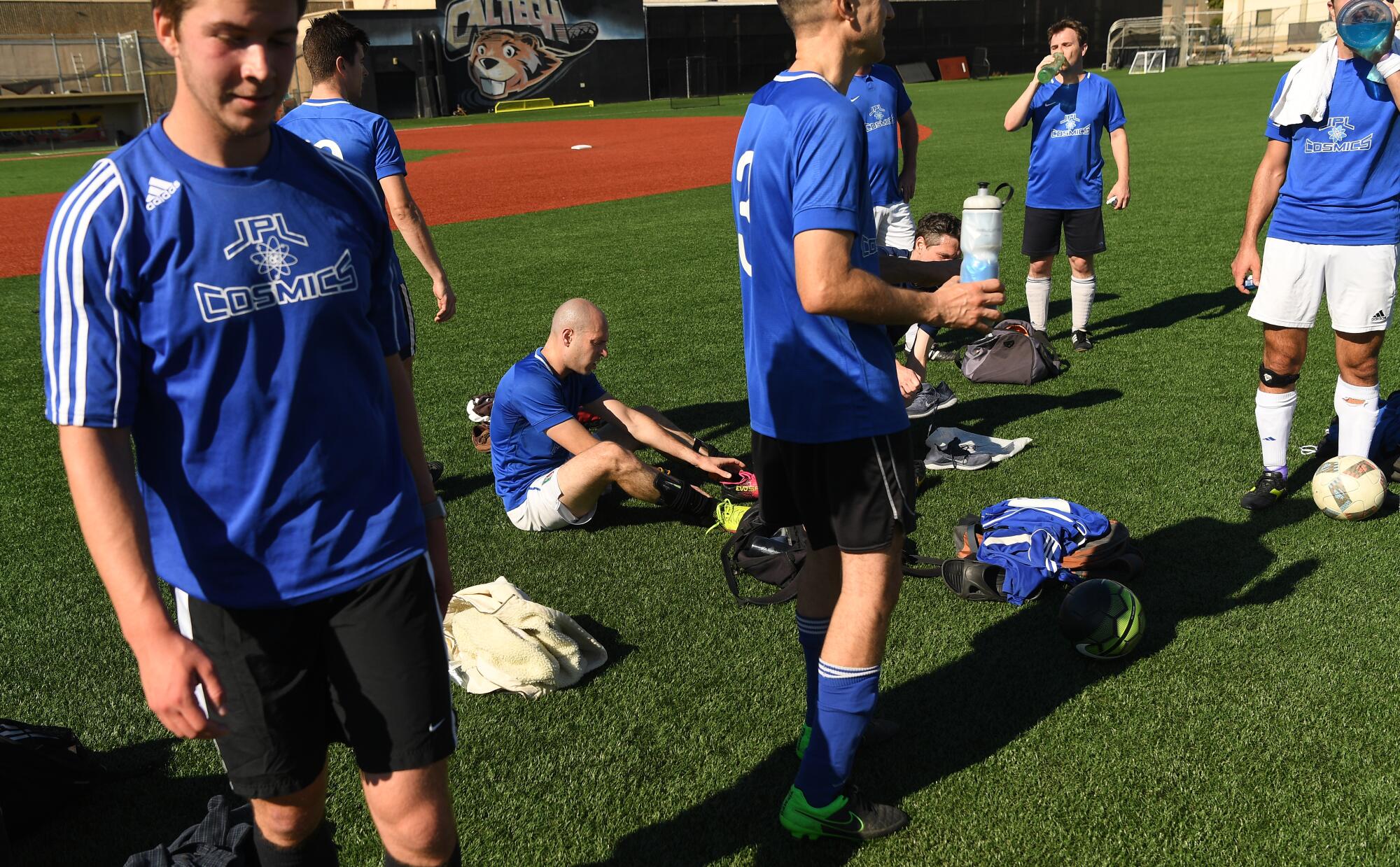
In the end, the SOPS’ youthfulness proved decisive. In the final minute Felix Hacker, a Swiss student working on a material science project with practical applications for soft robotics, scored off the deflection of a free kick to earn a tie, keeping the team in first place.
Like many scientific endeavors, the result was open to peer review — and the consensus is the results don’t matter all that much. For Heverly, who has played in the league for 20 years — or about twice as long as Landon Donovan played for the Galaxy — every game is a win no matter what the scoreboard shows.
“We’ve played in this league for a long time. It’s people I’ve known for 15 years,” said Heverly, who trudged off the field still checking his tongue for blood. “This is more ‘get out on a Sunday, run around and have fun.’ You make connections here on the soccer field and they pay off at work.”
Even when your work is on Mars.
More to Read
Go beyond the scoreboard
Get the latest on L.A.'s teams in the daily Sports Report newsletter.
You may occasionally receive promotional content from the Los Angeles Times.

